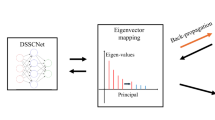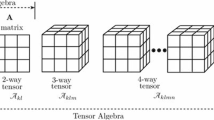Abstract
With the development of face recognition using sparse representation based classification (SRC), many relevant methods have been proposed and investigated. However, when the dictionary is large and the representation is sparse, only a small proportion of the elements contributes to the l 1-minimization. Under this observation, several approaches have been developed to carry out an efficient element selection procedure before SRC. In this paper, we employ a metric learning approach which helps find the active elements correctly by taking into account the interclass/intraclass relationship and manifold structure of face images. After the metric has been learned, a neighborhood graph is constructed in the projected space. A fast marching algorithm is used to rapidly select the subset from the graph, and SRC is implemented for classification. Experimental results show that our method achieves promising performance and significant efficiency enhancement.
Similar content being viewed by others
References
Arandjelovic, O., Shakhnarovich, G., Fisher, J., et al., 2005. Face recognition with image sets using manifold density divergence. Proc. IEEE Conf. on Computer Vision and Pattern Recognition, p.581–588. [doi:10.1109/CVPR.2005.151]
Belkin, M., Niyogi, P., 2001. Laplacian eigenmaps and spectral techniques for embedding and clustering. NIPS, 14:585–591.
Candès, E.J., 2008. The restricted isometry property and its implications for compressed sensing. Compt. Rend. Math., 346(9-10):589–592. [doi:10.1016/j.crma. 2008.03.014]
Candès, E.J., Tao, T., 2007. The Dantzig selector: statistical estimation when p is much larger than n. Ann. Stat., 35(6):2313–2351. [doi:10.1214/009053606000001523]
Deng, W.H., Hu, J.N., Guo, J., 2012. Extended SRC: undersampled face recognition via intraclass variant dictionary. IEEE Trans. Patt. Anal. Mach. Intell., 34(9):1864–1870. [doi:10.1109/TPAMI.2012.30]
Efron, B., Hastie, T., Johnstone, I., et al., 2004. Least angle regression. Ann. Stat., 32(2):407–499. [doi:10.1214/009053604000000067]
Georghiades, A.S., Belhumeur, P.N., Kriegman, D., 2001. From few to many: illumination cone models for face recognition under variable lighting and pose. IEEE Trans. Patt. Anal. Mach. Intell., 23(6):643–660. [doi:10.1109/34.927464]
He, R., Zheng, W.S., Hu, B.G., 2011. Maximum correntropy criterion for robust face recognition. IEEE Trans. Patt. Anal. Mach. Intell., 33(8):1561–1576. [doi:10.1109/TPAMI.2010.220]
He, R., Zheng, W.S., Hu, B.G., et al., 2013. Two-stage nonnegative sparse representation for large-scale face recognition. IEEE Trans. Neur. Netw. Learn. Syst., 24(1):35–46. [doi:10.1109/TNNLS.2012.2226471]
He, R., Zheng, W.S., Tan, T.N., et al., 2014. Half-quadratic-based iterative minimization for robust sparse representation. IEEE Trans. Patt. Anal. Mach. Intell., 36(2):261–275. [doi:10.1109/TPAMI.2013.102]
Jiang, Z.L., Lin, Z., Davis, L.S., 2011. Learning a discriminative dictionary for sparse coding via label consistent K-SVD. Proc. IEEE Conf. on Computer Vision and Pattern Recognition, p.1697–1704. [doi:10.1109/CVPR.2011.5995354]
Lai, Z.H., Li, Y.J., Wan, M.H., et al., 2013. Local sparse representation projections for face recognition. Neur. Comput. Appl., 23(7):2231–2239. [doi:10.1007/s00521-012-1174-0]
Liao, S.C., Jain, A.K., Li, S.Z., 2013. Partial face recognition: alignment-free approach. IEEE Trans. Patt. Anal. Mach. Intell., 35(5):1193–1205. [doi:10.1109/TPAMI.2012.191]
Lu, J.W., Tan, Y.P., Wang, G., 2013. Discriminative multimanifold analysis for face recognition from a single training sample per person. IEEE Trans. Patt. Anal. Mach. Intell., 35(1):39–51. [doi:10.1109/TPAMI. 2012.70]
Martínez, A., Benavente, B., 1998. The AR Face Database. CVC Technical Report 24.
Ortiz, E.G., Becker, B.C., 2014. Face recognition for webscale datasets. Comput. Vis. Image Understand., 118:153–170. [doi:10.1016/j.cviu.2013.09.004]
Patel, V.M., Wu, T., Biswas, S., et al., 2012. Dictionarybased face recognition under variable lighting and pose. IEEE Trans. Inform. Forens. Secur., 7(3):954–965. [doi:10.1109/TIFS.2012.2189205]
Phillips, P.J., Wechsler, H., Huang, J., et al., 1998. The FERET database and evaluation procedure for facerecognition algorithms. Image Vis. Comput., 16(5): 295–306. [doi:10.1016/S0262-8856(97)00070-X]
Roweis, S.T., Saul, L.K., 2000. Nonlinear dimensionality reduction by locally linear embedding. Science, 290(5500):2323–2326. [doi:10.1126/science.290.5500. 2323]
Sethian, J.A., 1999. Fast marching methods. SIAM Rev., 41(2):199–235. [doi:10.1137/S0036144598347059]
Seung, H.S., Lee, D.D., 2000. The manifold ways of perception. Science, 290(5500):2268–2269. [doi:10.1126/science.290.5500.2268]
Tenenbaum, J.B., de Silva, V., Langford, J.C., 2000. A global geometric framework for nonlinear dimensionality reduction. Science, 290(5500):2319–2323. [doi:10.1126/science.290.5500.2319]
Tibshirani, R., 1996. Regression shrinkage and selection via the lasso. J. R. Stat. Soc. Ser. B, 58(1):267–288.
Vandenberghe, L., Boyd, S., 1996. Semidefinite programming. SIAM Rev., 38(1):49–95. [doi:10.1137/1038003]
Wagner, A., Wright, J., Ganesh, A., et al., 2012. Toward a practical face recognition system: robust alignment and illumination by sparse representation. IEEE Trans. Patt. Anal. Mach. Intell., 34(2):372–386. [doi:10.1109/TPAMI.2011.112]
Wang, L.F., Wu, H.Y., Pan, C.H., 2015. Manifold regularized local sparse representation for face recognition. IEEE Trans. Circ. Syst. Video Technol., 25(4): 651–659. [doi:10.1109/TCSVT.2014.2335851]
Wang, R.P., Shan, S.G., Chen, X.L., et al., 2008. Manifoldmanifold distance with application to face recognition based on image set. Proc. IEEE Conf. on Computer Vision and Pattern Recognition, p.1–8. [doi:10.1109/CVPR.2008.4587719]
Weinberger, K.Q., Saul, L.K., 2009. Distance metric learning for large margin nearest neighbor classification. J. Mach. Learn. Res., 10:207–244. [doi:10.1145/1577069.1577078]
Wright, J., Yang, A.Y., Ganesh, A., et al., 2009. Robust face recognition via sparse representation. IEEE Trans. Patt. Anal. Mach. Intell., 31(2):210–227. [doi:10.1109/TPAMI.2008.79]
Xu, Y., Zuo, W.M., Fan, Z.Z., 2012. Supervised sparse representation method with a heuristic strategy and face recognition experiments. Neurocomputing, 79:125–131. [doi:10.1016/j.neucom.2011.10.013]
Xu, Y., Zhu, Q., Fan, Z.Z., et al., 2013. Using the idea of the sparse representation to perform coarse-to-fine face recognition. Inform. Sci., 238:138–148. [doi:10.1016/j.ins.2013.02.051]
Yang, M., Zhang, L., 2010. Gabor feature based sparse representation for face recognition with gabor occlusion dictionary. Proc. 11th European Conf. on Computer Vision, p.448–461. [doi:10.1007/978-3-642-15567-3_33]
Yang, M., Zhang, D., Yang, J., 2011. Robust sparse coding for face recognition. Proc. IEEE Conf. on Computer Vision and Pattern Recognition, p.625–632. [doi:10.1109/CVPR.2011.5995393]
Yu, Z.P., Wu, Z.D., Zhang, J.W., 2013. An illumination robust algorithm for face recognition via SRC and Gradientfaces. Proc. 2nd Int. Conf. on Innovative Computing and Cloud Computing, p.36–40. [doi:10.1145/2556871.2556880]
Zhang, D., Yang, M., Feng, X.C., 2011. Sparse representation or collaborative representation: which helps face recognition? Proc. IEEE Int. Conf. on Computer Vision, p.471–478. [doi:10.1109/ICCV.2011.6126277]
Zhang, Q., Li, B.X., 2010. Discriminative K-SVD for dictionary learning in face recognition. Proc. IEEE Conf. on Computer Vision and Pattern Recognition, p.2691–2698. [doi:10.1109/CVPR.2010.5539989]
Zhou, T.Y., Tao, D.C., Wu, X.D., 2011. Manifold elastic net: a unified framework for sparse dimension reduction. Data Min. Knowl. Discov., 22(3):340–371. [doi:10.1007/s10618-010-0182-x]
Author information
Authors and Affiliations
Corresponding author
Additional information
Project supported by the Natural Science Foundation of Liaoning Province, China (No. 201202162)
ORCID: Shuang CHEN, http://orcid.org/0000-0001-7441-4749
Rights and permissions
About this article
Cite this article
Shao, H., Chen, S., Zhao, Jy. et al. Face recognition based on subset selection via metric learning on manifold. Frontiers Inf Technol Electronic Eng 16, 1046–1058 (2015). https://doi.org/10.1631/FITEE.1500085
Received:
Accepted:
Published:
Issue Date:
DOI: https://doi.org/10.1631/FITEE.1500085




